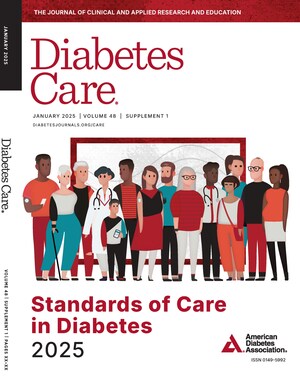American Diabetes Association® Issues Consensus Report to Standardize Definitions and Outcome Measures Beyond HbA1C for Type 1 Diabetes in Special Diabetes Care Section
Special section includes Consensus Report and new CGM research highlighting the critical value of data from CGM devices. Issue explores how outcomes beyond HbA1C can lead to improved individualized diabetes care plans, patient-reported outcomes and quality of life
ARLINGTON, Va., Nov. 21, 2017 /PRNewswire-USNewswire/ -- In clinical and research settings, diabetes management and glycemic control are assessed using Hemoglobin A1C (HbA1C) testing, which provides a measurement of a person's mean blood glucose levels over the past three months. HbA1C is also a surrogate measure for a person's risk of developing diabetes-related complications. However, despite the tremendous value of the HbA1C to clinical management, there are limitations to what the HbA1C can tell patients and physicians about their diabetes. The measurement does not capture short-term variations in blood glucose, exposure to hypoglycemia and hyperglycemia, or the impact of blood glucose variations on individuals' quality of life. Recent advances in type 1 diabetes (T1D) technologies and research have made it feasible to assess the efficacy of therapies and technologies using a set of outcomes beyond HbA1C, and to refine definitions of outcomes such as hypoglycemia. However, while definitions for hypoglycemia in clinical care exist, they are not standardized, causing inconsistency in the definitions used in different research studies. This impedes their use in clinical practice, as well as in the development processes for new therapies. A lack of standardized definitions also makes comparison of studies in the literature challenging and may lead to regulatory and reimbursement decisions that fail to meet the needs of people with diabetes.
To address this issue, the Type 1 Diabetes Outcomes Program was launched to develop consensus definitions for a set of priority outcomes for T1D. The Consensus Report, titled "Standardizing Clinically Meaningful Outcome Measures Beyond HbA1C for Type 1 Diabetes: A Consensus Report of the American Association of Clinical Endocrinologists, the American Association of Diabetes Educators, the American Diabetes Association, the Endocrine Society, JDRF International, The Leona M. and Harry B. Helmsley Charitable Trust, the Pediatric Endocrine Society, and the T1D Exchange," will be published online at 3:00 pm ET, Tuesday, November 21, 2017 at: http://care.diabetesjournals.org/lookup/doi/10.2337/dc17-1624 and in the December 2017 issue of Diabetes Care.
The special section also includes:
- A commentary by ADA leadership, titled "Maturation of CGM and Glycemic Measurements Beyond HbA1C— A Turning Point in Research and Clinical Decisions;"
- The joint scientific statement from the ADA and the European Association for the Study of Diabetes, "Improving the Clinical Value and Utility of CGM Systems: Issues and Recommendations;"
- The "International Consensus on Use of Continuous Glucose Monitoring;" and
- Four research papers highlighting the need for the expanded glycemic data provided by CGM devices.
The Beyond HbA1C Consensus Report, Commentary, International Consensus on CGM monitoring and related CGM research will be published in the December 2017 issue of Diabetes Care, which posts online on at 3:00 p.m. ET, Tuesday, November 21, 2017.
"This Consensus Report is a significant step towards providing standardized methods for improving how we evaluate therapies and technologies designed to treat and assist in the management of T1D and the prevention of its complications," said ADA's Chief Scientific, Medical and Mission Officer William T. Cefalu, MD. "Together, expanded data provided by CGMs along with uniform definitions will ultimately help us provide more carefully crafted and individualized diabetes care plans, and thus improve health outcomes as well as patient quality of life. Partnerships such as the Type 1 Diabetes Outcomes Program, convened by JDRF, are essential for us to make these important shifts across the diabetes landscape—from clinical care to research to outcomes to quality of life."
The Consensus Report was produced by a Steering Committee of leaders from each of the authoring organizations. Together, they reviewed an extensive body of literature and considered input from researchers, industry and people with diabetes to develop identify and define clinically meaningful ways to measure outcomes beyond HbA1C in people with T1D. Consensus definitions were created for hypoglycemia, hyperglycemia, time in range (proportions of time in glucose target ranges during continue glucose monitoring) and diabetic ketoacidosis (DKA). The Consensus Report also addresses patient-reported outcomes (PROs) and the need to further research on how best to measure these outcomes. The report emphasizes that HbA1C remains an important measure, and that the newly standardized definitions of these clinical additional outcomes provide supplemental methods of capturing a more comprehensive understanding of how interventions might affect the health of people with diabetes. A goal of the Type 1 Diabetes Outcomes Program is to ensure that that the defined outcomes are included as primary and secondary endpoints in T1D research, development and future therapy evaluation.
T1D is an autoimmune disease affecting the pancreas of both children and adults resulting in an absolute deficiency in insulin, a necessary hormone for the body to process sugar and carbohydrates into energy. People with type 1 diabetes must receive daily doses of insulin based upon blood glucose levels. Type 2 diabetes (T2D) occurs when the body is unable to use insulin properly and the pancreas is unable to produce enough insulin to compensate. T2D is a progressive disease (without proper management, T2D gets worse over time). All individuals with T1D and T2D who use insulin need to check their blood glucose levels throughout the day in order to determine the appropriate dose of insulin needed to keep their blood glucose within a safe range. Hypoglycemia (low blood glucose levels) can lead to seizures, coma or death; and, over time, uncontrolled blood glucose (hyperglycemia or high blood glucose levels) can lead to kidney, heart, nerve and eye damage.
About the American Diabetes Association
Nearly half of American adults have diabetes or prediabetes; more than 30 million adults and children have diabetes; and every 21 seconds, another individual is diagnosed with diabetes in the U.S. Founded in 1940, the American Diabetes Association (ADA) is the nation's leading voluntary health organization whose mission is to prevent and cure diabetes, and to improve the lives of all people affected by diabetes. The ADA drives discovery by funding research to treat, manage and prevent all types of diabetes, as well as to search for cures; raises voice to the urgency of the diabetes epidemic; and works to safeguard policies and programs that protect people with diabetes. In addition, the ADA supports people living with diabetes, those at risk of developing diabetes, and the health care professionals who serve them through information and programs that can improve health outcomes and quality of life. For more information, please call the ADA at 1-800-DIABETES (1-800-342-2383) or visit diabetes.org. Information from both of these sources is available in English and Spanish. Find us on Facebook (American Diabetes Association), Twitter (@AmDiabetesAssn) and Instagram (@AmDiabetesAssn).
SOURCE American Diabetes Association
Related Links
WANT YOUR COMPANY'S NEWS FEATURED ON PRNEWSWIRE.COM?
Newsrooms &
Influencers
Digital Media
Outlets
Journalists
Opted In






Share this article